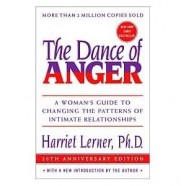
There is one book I’ve yet to write about, and it’s perhaps one of the most recommended readings I share with clients. It’s The Dance of Anger (’85, ’97, ’05) – a “New York Times Bestseller” by psychologist Harriet Lerner, Ph.D. Despite the subtitle, A Woman’s Guide to Changing the Patterns of Intimate Relationships, I recommend it to as many men as women. Although Dr. Lerner uses the “Dance” theme in several other books (The Dance of Fear; The Dance of Connection; The Dance of Deception; The Dance of Intimacy), The Dance of Anger is unquestionably her most popular “Dance” publication.
Chapter 1, “The Challenge of Anger,” begins:
“Anger is a signal, and one worth listening to. Our anger may be a message that we are being hurt, that our rights are being violated, that our needs or wants are not being adequately met, or simply that something is not right. Our anger may tell us that we are not addressing an important emotional issue in our lives, or that too much of our self – our beliefs, values, desires, or ambitions – is being compromised in a relationship. Our anger may be a signal that we are doing more and giving more than we can comfortably do or give. Or, our anger may warn us that others are doing too much for us, at the expense of our own competence and growth. Just as physical pain tells us to take our hand off the hot stove, the pain of our anger preserves the very integrity of our self. Our anger can motivate us to say ‘no’ to the ways in which we are defined by others and ‘yes’ to the dictates of our inner self.” (p. 1)
I’ve noted in previous blogs that the term “emotion” literally means “to move.” Emotions “move” us to say and/or do something. For example, depression often moves us to address perceived or actual “loss” in our lives. Anxiety moves us to address perceived or actual “threat”. Happiness moves us to express “joy”. Anger, as Dr. Lerner notes, moves us to address something we’re wanting/needing, or not. And, sadness or anxiety can look a lot like anger! In other words, anger on a continuum (frustration ->resentment ->rage) is often the outward manifestation of feeling sad/depressed, or scared/anxious; like losing our child in the shopping mall, but getting angry when we find them. The reason we get angry is because the temporary loss of our child’s whereabouts scares us. So, I am continually asking angry clients what it is they want/need, or not; a seemingly obvious question with important implications. Once the question is answered (which may take some time), it becomes the essence of assertive communication (“polite, but powerful” communication) with others; for example, “I’m frustrated (Angry!) that I’m never asked about my day. I’d like for you to ask me about my day!” Like a tennis game, we volley our wants and needs over the net – in the hope that the receiver will play. If not (mixing metaphors), we access our “trump card question”: “What am I prepared to do if s/he is unwilling–perhaps unable–to work with me?” I’ll illustrate the “trump card question” using one of Harriet Lerner’s examples:
“Larry’s pattern of leaving household jobs half finished was a real irritant to Sandra. The typical old pattern was that Sandra would push Larry to finish a task, in response to which he would procrastinate further, which provoked Sandra in pushing harder. The circular dance was procrastinate-push-procrastinate-push…As is often the case, Sandra’s pushing actually helped Larry to be more comfortable with his irresponsible behavior. He would become angry and defensive in the face of her criticisms, which protected him from feeling guilty and concerned about his difficulty completing tasks….Now, Sandra is clear in telling Larry that she becomes upset when the bathroom ceiling remains half painted and buckets of paint are lying around the house. If Larry shows no positive response to her complaint, Sandra then puts her energy into determining what she will do or will not do in order to take care of her own needs. She is able to do this when she begins to feel resentful….Thus she can talk to Larry without hostility and let him know that she is needing to do something for herself and not to him. After considering the options open to her, she may choose to say any number of things to Larry. It may be: ‘Okay, I don’t like it, but I can live with it.’ Or, ‘Larry I would rather you finish what you began, but if you are unable to do so this week, it is bothersome enough to me that I will do it myself. I can paint it without becoming angry, so that’s okay with me.’ Or, ‘I can only tolerate looking at this unfinished job for one more week, and I can’t complete it myself without becoming angry about it. So, what might we do that you don’t feel pushed and I don’t become furious? One idea I have is to call the painter if it’s not done by Saturday.'” (pp. 65-66)
That’s an example of what I mean by the “trump card question”. I assure you that Harriet Lerner’s The Dance of Anger is worth the read!

